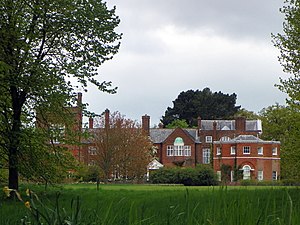
St. Paul's Walden Bury is an English country house and surrounding gardens in the village of St Paul's Walden in Hertfordshire. The house is a Grade II* listed, and the gardens Grade I.
A home of the Bowes-Lyon family, it is possibly the site of the birth of Queen Elizabeth, the Queen Mother.
The garden wilderness, or highly formalized woodland, is a very rare survival, and the "most perfect surviving" English example. It was laid out in the 1730s with straight walks in the old formal style, when these were already becoming rather unfashionable.
The house, of red brick with stone dressings and slate roofs, was built around the 1730s for Edward Gilbert (1680–1762). His daughter Mary married George Bowes of Gibside, Durham, and the estate has been in the possession of the Bowes or Bowes-Lyon family since 1720. James Paine made alterations to the house in the 1770s, which was also extended to the rear in the late nineteenth century.
Gardens
The St Paul's Walden Bury gardens' design is largely contemporary with the house, with additional 19th and 20th-century woodland garden areas. Geoffrey Jellicoe (1900–1996), the landscape designer, restored and "improved" the 18th-century work. There are three straight grassed allées radiating in patte d'oie ("goose foot") formation from the garden front of the house. The garden is notable for one of the best surviving formal wildernesses. Each allée is flanked by clipped beech hedges. In the 1950s a circular temple designed by James Wyatt was rescued and brought here from Copped Hall, Essex, when that house burned down. There are a number of other garden buildings and statues, some 18th-century, and an 18th-century walled kitchen garden, nearly square and divided in two parts by a further wall.
In 1987 the gardens were designated Grade I on the Register of Historic Parks and Gardens of Special Historic Interest in England.
References
- 1901 England Census, Class RG13, piece 1300, folio 170, p. 5
- Uglow, Jenny, A Little History of British Gardening, 2004, p. 118, Chatto & Windus, ISBN 0701169281
- Historic England. "THE BURY (1307601)". National Heritage List for England. Retrieved 28 December 2015.
- ^ "St Paul's Walden Bury". Garden Visit. Retrieved 1 February 2016.
- ^ Historic England. "St Paul's Walden Bury (1000150)". National Heritage List for England. Retrieved 11 October 2013.
- Clark, Robert, Wilderness and Shrubbery in Austen’s Works, Section 5, Persuasions On-line, The Jane Austen Society of America, Volume 36, No. 1 — Winter 2015
External links
- St Paul's Walden Bury – Official website
- St. Paul's Walden Bury entry from The DiCamillo Companion to British & Irish Country Houses
51°52′52″N 0°16′34″W / 51.88111°N 0.27611°W / 51.88111; -0.27611
Categories: